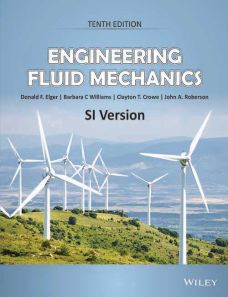Engineering Fluid Mechanics, 10ed, SI Version
ISBN: 9788126564491
692 pages
For more information write to us at: acadmktg@wiley.com

Description
The 10th edition of Crowe's Engineering Fluid Mechanics will build upon the strengths and success of the 9th edition, including a focus on pedigogical support and providing considering deeper support for development of conceptual understanding and problem solving. This new edition retains the hallmark features of Crowe's distinguished history: clarity of coverage, strong examples and practice problems, and comprehensiveness of material, but expands coverage to Computational Fluid Dynamics-a topic missed in earlier editions.
Preface
Chapter 1 Building a Solid Foundation
1.1 Defining Engineering Fluid Mechanics
1.2 Describing Liquids and Gases
1.3 Idealizing Matter
1.4 Dimensions and Units
1.5 Carrying and Canceling Units
1.6 Applying the Ideal Gas Law (IGL)
1.7 The Wales-Woods Model
1.8 Checking for Dimensional Homogeneity (DH)
1.9 Summarizing Key Knowledge
Chapter 2 Fluid Properties
2.1 Defining the System
2.2 Characterizing Mass and Weight
2.3 Modeling Fluids as Constant Density
2.4 Finding Fluid Properties
2.5 Describing Viscous Effects
2.6 Applying the Viscosity Equation
2.7 Characterizing Viscosity
2.8 Characterizing Surface Tension
2.9 Predicting Boiling Using Vapor Pressure
2.10 Characterizing Thermal Energy in Flowing Gases
2.11 Summarizing Key Knowledge
Chapter 3 Fluid Statics
3.1 Describing Pressure
3.2 Calculating Pressure Changes Associated with Elevation Changes
3.3 Measuring Pressure
3.4 Predicting Forces on Plane Surfaces (Panels)
3.5 Calculating Forces on Curved Surfaces
3.6 Calculating Buoyant Forces
3.7 Predicting Stability of Immersed and Floating Bodies
3.8 Summarizing Key Knowledge
Chapter 4 The Bernoulli Equation and Pressure Variation
4.1 Describing Streamlines, Streaklines and Pathlines
4.2 Characterizing Velocity of a Flowing Fluid
4.3 Describing Flow
4.4 Acceleration
4.5 Applying Euler's Equation to Understand Pressure Variation
4.6 Applying the Bernoulli Equation along a Streamline
4.7 Measuring Velocity and Pressure
4.8 Characterizing Rotational Motion of a Flowing Fluid
4.9 The Bernoulli Equation for Irrotational Flow
4.10 Describing the Pressure Field for Flow over a Circular Cylinder
4.11 Calculating the Pressure Field for a Rotating Flow
4.12 Summarizing Key Knowledge
Chapter 5 Control Volume Approach and Continuity Equation
5.1 Characterizing the Rate of Flow
5.2 The Control Volume Approach
5.3 Continuity Equation (Theory)
5.4 Continuity Equation (Application)
5.5 Predicting Caviation
5.6 Summarizing Key Knowledge
Chapter 6 Momentum Equation
6.1 Understanding Newton's Second Law of Motion
6.2 The Linear Momentum Equation: Theory
6.3 Linear Momentum Equation: Application
6.4 The Linear Momentum Equation for a Stationary Control Volume
6.5 Examples of the Linear Momentum Equation (Moving Objects)
6.6 The Angular Momentum Equation
6.7 Summarizing Key Knowledge
Chapter 7 The Energy Equation
7.1 Energy Concepts
7.2 Conservation of Energy
7.3 The Energy Equation
7.4 The Power Equation
7.5 Mechanical Efficiency
7.6 Contrasting the Bernoulli Equation and the Energy Equation
7.7 Transitions
7.8 Hydraulic and Energy Grade Lines
7.9 Summarizing Key Knowledge
Chapter 8 Dimensional Analysis and Similitude
8.1 Need for Dimensional Analysis
8.2 Buckingham II Theorem
8.3 Dimensional Analysis
8.4 Common p-Groups
8.5 Similitude
8.6 Model Studies for Flows without Free-Surface Effects
8.7 Model-Prototype Performance
8.8 Approximate Similitude at High Reynolds Numbers
8.9 Free-Surface Model Studies
8.10 Summarizing Key Knowledge
Chapter 9 Predicting Shear Force
9.1 Uniform Laminar Flow
9.2 Qualitative Description of the Boundary Layer
9.3 Laminar Boundary Layer
9.4 Boundary Layer Transition
9.5 Turbulent Boundary Layer
9.6 Pressure Gradient Effects of Boundary Layers
9.7 Summarizing Key Knowledge
Chapter 10 Flow in Conduits
10.1 Classifying Flow
10.2 Specifying Pipe Sizes
10.3 Pipe Head Loss
10.4 Stress Distributions in Pipe Flow
10.5 Laminar Flow in a Round Tube
10.6 Turbulent Flow and the Moody Diagram
10.7 Strategy for Solving Problems
10.8 Combined Head Loss
10.9 Nonround Conduits
10.10 Pumps and Systems of Pipes
10.11 Key Knowledge
Chapter 11 Drag and Lift
11.1 Relating Lift and Drag to Stress Distributions
11.2 Calculating Drag Force
11.3 Drag of Axisymmetric and 3-D Bodies
11.4 Terminal Velocity
11.5 Vortex Shedding
11.6 Reducing Drag by Streamlining
11.7 Drag in Compressible Flow
11.8 Theory of Lift
11.9 Lift and Drag on Airfoils
11.10 Lift and Drag on Road Vehicles
11.11 Summarizing Key Knowledge
Chapter 12 Compressible Flow
12.1 Wave Propagation in Compressible Fluids
12.2 Mach Number Relationships
12.3 Normal Shock Waves
12.4 Isentropic Compressible Flow Through a Duct with Varying Area
12.5 Summarizing Key Knowledge
Chapter 13 Flow Measurements
13.1 Measuring Velocity and Pressure
13.2 Measuring Flow Rate (Discharge)
13.3 Measurement in Compressible Flow
13.4 Accuracy of Measurements
13.5 Summarizing Key Knowledge
Chapter 14 Turbomachinery
14.1 Propellers
14.2 Axial-Flow Pumps
14.3 Radial-Flow Machines
14.4 Specific Speed
14.5 Suction Limitations of Pumps
14.6 Viscous Effects
14.7 Centrifugal Compressors
14.8 Turbines
14.9 Summarizing Key Knowledge
Chapter 15 Flow in Open Channels
15.1 Description of Open-Channel Flow
15.2 Energy Equation for Steady Open-Channel Flow
15.3 Steady Uniform Flow
15.4 Steady Non uniform Flow
15.5 Rapidly Varied Flow
15.6 Hydraulic Jump
15.7 Gradually Varied Flow
15.8 Summarizing Key Knowledge
Chapter 16 Modeling of Fluid Dynamics Problems
16.1 Models in Fluid Mechanics
16.2 Foundations for Learning Partial Differential Equations (PDEs)
16.3 The Continuity Equation
16.4 The Navier-Stokes Equation
16.5 Computational Fluid Dynamics (CFD)
16.6 Examples of CFD
16.7 A Path for Moving Forward
16.8 Summarizing Key Knowledge
Appendix
Answers
Index

